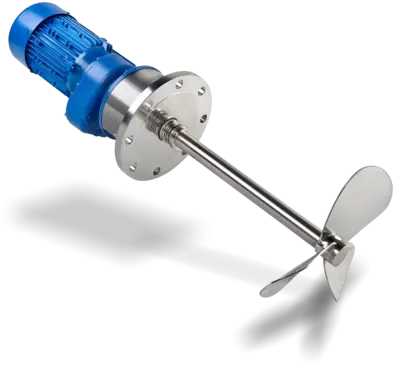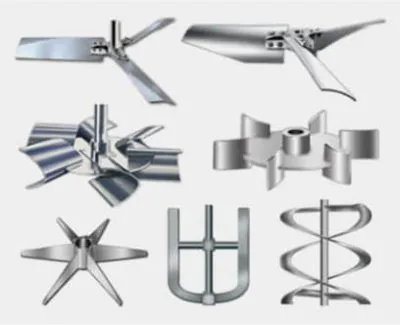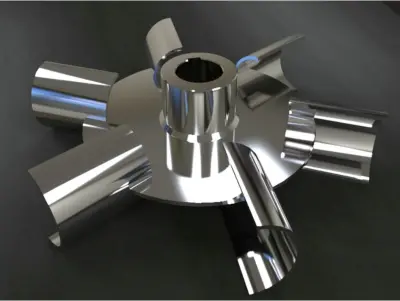Introduction of Tank Agitator
A tank agitator is a device used in industrial processes to mix or stir the contents of a tank or vessel. It is commonly used in industries such as chemical processing, pharmaceuticals, food and beverage, and water treatment.
The primary purpose of a tank agitator is to promote mixing and ensure uniformity of the liquid or slurry inside the tank. It helps prevent settling of solids, maintains the desired temperature distribution, aids in chemical reactions, and facilitates the transfer of heat or mass between the tank contents and the agitator.
Tank agitators typically consist of a rotating impeller or blade that creates turbulence and fluid motion within the tank. The impeller is driven by a motor, which can be mounted on top of the tank or externally. The impeller design can vary depending on the specific application and the characteristics of the mixture being agitated. Some common types of impellers include axial flow, radial flow, and mixed flow designs.
As one of the most professional tank agitator manufacturers in China, SeFluid’s professional team has been dedicated to designing and manufacturing the most suitable and efficient tank agitator for users for many years. With quick response and timely service, we provide various solutions and customized services for customers from all over the world, and have won wide trust from them.
Mounting Types of Tank Agitator
Agitators can be classified based on their mounting configuration. The most common types are:
- Top-Mounted Agitators: These agitators are mounted on the top of the tank and are generally used for low-viscosity fluids. They can be fixed or swiveling types and are suitable for blending, suspension, or circulation applications.
- Side-Mounted Agitators: These agitators are mounted on the side of the tank and are commonly used for larger tanks or when top entry is not feasible. Side-mounted agitators are often used for mixing viscous or high-density fluids, where additional shear is required.
- Bottom-Mounted Agitators: These agitators are mounted on the bottom of the tank and are used for mixing settled solids or slurries. They are designed to agitate the contents from the bottom and keep them in suspension.

Specification
Power: 1.5-100 kw
Capacity: 1.5-110 m³/h
Material: SS304/SS316
RPM: 0-2930
Structure of Tank Agitator


The structure of a tank agitator can vary depending on the specific design and application requirements. However, the basic components of a tank agitator typically include:
- Motor: The motor is the primary power source of the agitator and provides the rotational force to drive the impeller. The motor can be electric, hydraulic, or pneumatic, depending on the application and available power source.
- Shaft: The shaft connects the motor to the impeller and transmits the rotational motion. It is usually made of a strong and corrosion-resistant material such as stainless steel.
- Impeller: The impeller is the rotating component responsible for creating fluid motion and mixing within the tank. It can have various designs, such as axial flow, radial flow, or mixed flow, depending on the specific application requirements. The impeller blades are designed to generate turbulence, shear, and circulation, promoting effective mixing of the tank contents.
- Support Structure: The agitator is typically supported by a framework or mounting structure that holds the motor and shaft in place. The support structure can be attached to the top, side, or bottom of the tank, depending on the agitator type and mounting configuration.
- Sealing Mechanism: In some cases, a sealing mechanism is employed to prevent leakage of the tank contents along the shaft. This is particularly important when the tank contains hazardous or corrosive substances. Sealing options can include packing seals, mechanical seals, or other specialized sealing arrangements.
- Controls and Instrumentation: Agitators may be equipped with controls and instrumentation systems to monitor and regulate the agitation process. This can include speed control, torque sensing, temperature sensors, and level sensors to optimize the mixing operation.
It’s important to note that the specific design and features of a tank agitator can vary widely depending on factors such as the size of the tank, the characteristics of the fluid being agitated, and the specific industry requirements. Customizations and additional components may be incorporated to meet the unique needs of different applications.
Impeller Shape of Tank Agitator
The impeller shape of a tank agitator plays a crucial role in determining the mixing performance and efficiency. Different impeller designs are used based on the specific application requirements and the characteristics of the fluid being agitated. Here are some commonly used impeller shapes:
- Radial Flow Impeller: This type of impeller consists of blades that extend radially from the center of the impeller. It promotes radial flow patterns, creating strong outward and inward fluid movement. Radial flow impellers are effective in applications requiring high flow rates and efficient mixing of low-viscosity fluids.
- Axial Flow Impeller: Axial flow impellers have blades that are angled parallel to the shaft axis. They generate axial flow patterns, where the fluid moves parallel to the shaft. Axial flow impellers are well-suited for applications requiring efficient mixing of high-viscosity fluids or when a strong axial flow is desired.
- Mixed Flow Impeller: Mixed flow impellers combine the characteristics of both radial and axial flow impellers. They have blades that are angled both radially and axially, combining the advantages of both flow patterns. Mixed flow impellers offer good circulation and mixing efficiency for a wide range of fluid viscosities.
- Propeller Impeller: Propeller impellers resemble the blades of a propeller and are commonly used for low-viscosity fluids. They generate a high flow rate and produce a good amount of axial flow. Propeller impellers are often used in applications requiring blending, solids suspension, or circulation.
- Turbine Impeller: Turbine impellers have a flat and wide design, with multiple curved blades. They are commonly used for high-viscosity or non-Newtonian fluids. Turbine impellers provide strong pumping action and shear forces, ensuring effective mixing and dispersion of viscous fluids.
- Paddle Impeller: Paddle impellers consist of flat blades that extend radially from the impeller hub. They are suitable for low-shear applications and are often used for gentle mixing, solid suspension, or heat transfer processes.
It’s important to select the appropriate impeller shape based on factors such as the fluid viscosity, desired flow pattern, mixing intensity, and the specific requirements of the process. Customized impeller designs can also be developed to meet unique application needs.
Design of Tank Agitator
The design of a tank agitator takes into account several factors to ensure efficient mixing and performance. Here are some key aspects considered during the design process:
- Tank Size and Geometry: The size and geometry of the tank play a significant role in determining the agitator design. The agitator should be appropriately sized to suit the tank dimensions, taking into account factors such as the tank volume, aspect ratio (height to diameter ratio), and the required mixing intensity.
- Agitation Requirements: The specific mixing requirements of the process are considered during the design. Factors such as the desired flow pattern, mixing intensity, and residence time are taken into account. This helps determine the appropriate type of impeller, impeller size, and rotational speed for optimal mixing performance.
- Fluid Properties: The characteristics of the fluid being agitated also influence the agitator design. Factors such as viscosity, density, rheology, and chemical properties (e.g., corrosiveness) are considered. These properties impact impeller selection, impeller shape, and materials of construction to ensure compatibility and efficient mixing.
- Impeller Selection: The choice of impeller is crucial for achieving the desired mixing performance. Factors such as flow pattern requirements, fluid viscosity, and shear sensitivity are considered when determining the impeller type (radial flow, axial flow, mixed flow, etc.) and impeller shape (blades, paddles, propellers, etc.).
- Power Requirements: The power required for agitator operation is determined based on factors such as the fluid properties, tank volume, and desired mixing intensity. This influences the selection of the motor size and the gearbox design, ensuring sufficient power transmission to the impeller.
- Mounting Configuration: The mounting configuration of the agitator depends on the tank design and process requirements. Common configurations include top-mounted, side-mounted, or bottom-mounted agitators. The mounting arrangement should provide stability, proper alignment, and accessibility for maintenance and cleaning.
- Material Selection: Agitator components must be constructed from materials that are compatible with the fluid being agitated. The material selection considers factors such as corrosion resistance, mechanical strength, and sanitary requirements (in food or pharmaceutical applications).
- Support Structure: The design of the support structure ensures stability and proper alignment of the agitator. It should be robust enough to handle the operational loads and vibrations associated with the agitation process.
- Controls and Instrumentation: Agitators may be integrated with control systems and instrumentation to monitor and adjust the mixing process. This can include speed control, torque sensing, temperature sensors, and level sensors for efficient operation and process optimization.
The design of a tank agitator is typically customized to suit specific application requirements, taking into account the process conditions and desired mixing outcomes. It involves a combination of engineering principles, fluid dynamics, and material science to ensure effective and reliable agitation.
Grearbox of Tank Agitator
The gearbox of a tank agitator is an important component that facilitates the transmission of power from the motor to the agitator shaft. It allows for speed control and torque adjustment, enabling the agitator to operate at the desired rotational speed and provide the necessary mixing intensity.
The gearbox typically consists of the following elements:
- Input Shaft: The input shaft connects to the motor and receives rotational motion from it. The input shaft transfers the power to the gearbox for further transmission.
- Gears: The gears are the main components within the gearbox that transmit power and control the speed and torque of the agitator. The gearbox may contain multiple gears arranged in different configurations, such as helical, spur, or planetary gears.
- Gear Ratio: The gear ratio determines the rotational speed and torque output of the agitator shaft in relation to the motor speed. By adjusting the gear ratio, the rotational speed of the agitator can be increased or decreased.
- Output Shaft: The output shaft is connected to the agitator shaft and transfers the rotational motion and torque from the gearbox to the agitator. The output shaft is responsible for driving the impeller and generating the required mixing action.
- Lubrication System: Gearboxes often incorporate a lubrication system to ensure smooth operation and reduce friction between the gears. Proper lubrication helps to extend the lifespan of the gearbox and maintain its efficiency.
- Housing: The gearbox is enclosed within a housing or casing that protects the internal components from external elements and provides structural support.
The selection of a gearbox for a tank agitator depends on factors such as the power requirements, rotational speed range, torque capacity, and the specific application’s operating conditions. The gearbox should be chosen to match the motor specifications and be capable of withstanding the mechanical stresses and loads associated with the agitation process.
Gearboxes for tank agitators are designed to be durable, reliable, and capable of operating in demanding industrial environments. They are often made of robust materials, such as cast iron or stainless steel, to ensure strength and resistance to corrosion or wear.
Seal of Tank Agitator
The seal of a tank agitator is a critical component that ensures the integrity of the system by preventing leaks and maintaining a secure enclosure. It is designed to contain the fluid being mixed within the tank and prevent it from escaping or entering the agitator shaft area. The seal plays a vital role in ensuring safety, operational efficiency, and environmental compliance. Here are some important aspects regarding the seal of a tank agitator:
- Leakage Prevention: The primary function of the seal is to prevent leakage of the fluid being mixed. This is particularly important when dealing with hazardous or corrosive substances, as even minor leaks can have severe consequences. The seal creates a barrier between the tank and the agitator shaft, ensuring that the fluid remains contained within the tank and does not leak into the surrounding environment.
- Shaft Protection: The seal also serves to protect the agitator shaft from the corrosive or abrasive nature of the fluid being mixed. It acts as a barrier that prevents the fluid from entering the shaft area, which could cause damage to the agitator’s internal components or compromise its performance. By effectively sealing the shaft, the seal extends the operational life of the agitator and reduces maintenance requirements.
- Compatibility: The seal of a tank agitator must be compatible with the fluid being mixed and the operating conditions. Different fluids have varying chemical properties, temperatures, and pressures, which can affect the seal’s performance. It is crucial to select a seal material that is resistant to the specific fluid and can withstand the operating conditions without degradation or failure.
- Types of Seals: There are various types of seals used in tank agitators, including mechanical seals, lip seals, and packing seals. Mechanical seals are commonly used in high-pressure or high-temperature applications and provide a reliable and robust sealing solution. Lip seals, also known as radial shaft seals, are suitable for moderate pressure and temperature conditions. Packing seals, which consist of a compressed packing material, are often used in applications with lower pressures and temperatures.
- Maintenance and Replacement: Regular inspection, maintenance, and replacement of the seal are essential for optimal performance and reliability. Over time, seals may wear out, become damaged, or lose their effectiveness, leading to leaks or reduced sealing efficiency. Following manufacturer recommendations and implementing a proactive maintenance program will help ensure that the seal is functioning properly and minimize the risk of unplanned downtime.
In summary, the seal of a tank agitator is a vital component that prevents leakage, protects the agitator shaft, and ensures the integrity of the system. By selecting a compatible seal material, choosing the appropriate seal type, and implementing regular maintenance, industries can rely on the seal to maintain a safe and efficient tank agitation process.
Material of Tank Agitator
The choice of material for a tank agitator depends on several factors, including the properties of the fluid being agitated, the operating conditions, and any specific industry requirements. Here are some common materials used for tank agitators:
- Stainless Steel: Stainless steel is a widely used material for tank agitators due to its excellent corrosion resistance and durability. Different grades of stainless steel, such as 304, 316, and 316L, are available, each offering varying levels of corrosion resistance to different chemicals and environments. Stainless steel is commonly used in industries such as food and beverage, pharmaceuticals, and chemical processing.
- Carbon Steel: Carbon steel is a cost-effective option for tank agitators, especially when corrosion resistance is not the primary concern. Carbon steel is strong and durable but may be susceptible to corrosion in certain aggressive chemical environments. Proper coating or lining can be applied to enhance its corrosion resistance.
- Hastelloy: Hastelloy is a family of nickel-based alloys known for their exceptional corrosion resistance in highly corrosive environments. Hastelloy alloys, such as Hastelloy C276 and Hastelloy C22, are commonly used in industries handling aggressive chemicals, acids, and high-temperature applications.
- Polypropylene (PP) or Polyethylene (PE): These thermoplastic materials are often used for tank agitators when high corrosion resistance and chemical inertness are required. PP and PE are lightweight, durable, and resistant to a wide range of chemicals. They are commonly used in industries such as water treatment, wastewater treatment, and chemical processing.
- Fiberglass Reinforced Plastic (FRP): FRP is a composite material that combines a polymer matrix with fiberglass reinforcement. FRP offers excellent corrosion resistance, high strength-to-weight ratio, and resistance to temperature and UV exposure. It is commonly used in applications where corrosion resistance is critical and weight reduction is desired.
- Exotic Alloys: In certain demanding applications, such as the handling of highly aggressive chemicals or extreme temperatures, specialized alloys like titanium, Monel, Inconel, or zirconium may be used. These alloys offer exceptional resistance to corrosion, high temperatures, and other harsh environments.
The material selection for a tank agitator is determined by factors such as the chemical compatibility with the process fluid, temperature range, mechanical strength requirements, and industry regulations or standards. It is important to consider these factors and consult with experts or engineers to ensure the appropriate material is chosen for the specific application.
Fluid Dynamics and Design of Tank Agitator

Fluid dynamics plays a crucial role in the design of tank agitators, as it helps optimize the performance and efficiency of the agitation process. Here are some key aspects of fluid dynamics that are considered in the design of tank agitators:
- Flow Patterns: Understanding fluid flow patterns within the tank is essential for effective mixing. Different flow patterns, such as axial flow, radial flow, or a combination of both, can be employed depending on the desired mixing objectives. Fluid dynamics analysis helps determine the appropriate flow pattern and impeller configuration to achieve the desired mixing results.
- Turbulence and Shear: Turbulence and shear play a significant role in promoting mixing and dispersing particles or substances within the tank. The design of the agitator, including the impeller shape, size, and rotational speed, is optimized to generate sufficient turbulence and shear forces. Fluid dynamics analysis helps evaluate the intensity and distribution of turbulence and shear in the tank to ensure efficient mixing.
- Power Consumption: Fluid dynamics principles are utilized to estimate the power consumption of the agitator. Factors such as fluid viscosity, density, and required flow rates are considered to determine the torque and power required to achieve the desired mixing performance. Understanding the flow characteristics and fluid properties aids in selecting an appropriately sized motor and gearbox to drive the agitator.
- Solid Suspension and Settling: Fluid dynamics analysis is employed to optimize the agitator design for solid suspension or prevention of settling. By considering factors such as particle size, density, and the rheological properties of the fluid, engineers can design agitators that create sufficient fluid motion to suspend solids and prevent their accumulation or settling at the bottom of the tank.
- Scale-Up Considerations: Fluid dynamics principles are also crucial when scaling up the design of tank agitators. Changes in tank size, impeller dimensions, and fluid properties can impact the fluid flow behavior and mixing efficiency. Fluid dynamics analysis aids in predicting the performance of agitators at different scales and ensures that the scaled-up design maintains the desired mixing characteristics.
Overall, fluid dynamics plays a fundamental role in the design of tank agitators. By considering flow patterns, turbulence, shear forces, power consumption, and solid suspension, engineers can optimize the design for efficient mixing and achieve the desired results in various industrial processes.
Scraper and Tank Agitator
A scraper is a mechanical device used in conjunction with a tank agitator to enhance the mixing and scraping of materials within a tank. It is designed to scrape the walls and bottom of the tank, ensuring efficient mixing, preventing material build-up, and promoting uniformity.
The combination of a scraper and tank agitator offers several advantages in various industrial processes. Here are some key points regarding the scraper and its integration with a tank agitator:
- Improved Mixing Efficiency: The scraper works in tandem with the tank agitator to enhance the mixing efficiency. While the agitator generates fluid motion and turbulence, the scraper ensures that the materials adhering to the tank walls or settling at the bottom are continuously mixed back into the main bulk. This promotes thorough mixing and prevents the formation of dead zones within the tank.
- Prevents Material Build-up: Certain materials, such as viscous fluids or sticky substances, tend to adhere to the tank walls and accumulate over time. The scraper’s primary function is to scrape off these materials, preventing their buildup and maintaining a clean tank surface. By removing the accumulated material, the scraper helps maintain consistent mixing performance and avoids potential contamination or blockages.
- Enhanced Heat Transfer: In processes where heat transfer is crucial, such as in heat exchangers or thermal reactors, the scraper and agitator combination facilitates improved heat transfer efficiency. By continuously scraping the heat transfer surfaces, the scraper prevents fouling or scaling, ensuring optimal heat exchange and maximizing process efficiency.
- Homogeneous Product Quality: The integration of a scraper with a tank agitator promotes the uniform distribution of ingredients, particles, or additives within the tank. This results in a homogeneous product quality, as the scraper prevents material segregation and ensures consistent blending throughout the tank. This is particularly valuable in industries such as chemical manufacturing, food processing, and pharmaceutical production.
- Customization and Adaptability: Scraper designs can be customized to suit specific tank configurations, sizes, and materials. They can be designed as rotating blades, continuous belts, or other configurations depending on the application requirements. The scraper can be integrated with different types of tank agitators, such as anchor agitators, propeller agitators, or turbine agitators, to achieve the desired mixing and scraping effect.
In summary, the integration of a scraper with a tank agitator offers numerous benefits, including improved mixing efficiency, prevention of material build-up, enhanced heat transfer, homogeneous product quality, and customization options. By incorporating a scraper into the tank agitator design, industrial processes can achieve optimal mixing performance, maintain cleanliness, and ensure consistent product quality.
SeFluid's Advantages on Design and Manufacturing of Tank Agitator


At SeFluid, we take pride in our expertise in the design and manufacturing of tank agitators. With years of experience and a commitment to innovation, we offer several distinct advantages that set us apart in the industry.
- Customized Solutions: We understand that each application has unique requirements. Therefore, we specialize in providing customized tank agitator solutions tailored to our clients’ specific needs. Our team of skilled engineers works closely with customers to understand their process parameters, fluid characteristics, and mixing goals. By leveraging our deep knowledge and expertise, we deliver tank agitators that optimize mixing efficiency, reduce energy consumption, and enhance overall performance.
- Fluid Dynamics Expertise: Fluid dynamics is at the core of tank agitator design. Our team consists of highly skilled engineers with extensive knowledge in fluid dynamics principles. We utilize advanced computational fluid dynamics (CFD) simulations to analyze fluid flow patterns, turbulence, and shear forces within the tank. This allows us to design agitators that ensure optimal mixing performance, even in the most challenging applications. By leveraging our fluid dynamics expertise, we provide agitator solutions that deliver superior results.
- Advanced Manufacturing Capabilities: Our state-of-the-art manufacturing facility is equipped with advanced machinery and tools to ensure precision and quality in every tank agitator we produce. We employ cutting-edge manufacturing techniques, including computer numerical control (CNC) machining, to fabricate agitator components with utmost accuracy and consistency. Our strict quality control measures throughout the manufacturing process ensure that each tank agitator meets the highest standards of performance and durability.
- Diverse Material Options: We offer a wide range of material options to suit different application requirements. Whether it’s stainless steel for corrosion resistance, carbon steel for cost-effectiveness, or specialized alloys for extreme environments, we have the expertise to select the most suitable materials for the tank agitator. Our knowledge of material compatibility and industry standards ensures that our agitators perform reliably and maintain their integrity over time.
- Comprehensive Support and Service: At SeFluid, our commitment to customer satisfaction goes beyond just delivering tank agitators. We provide comprehensive support and service throughout the entire project lifecycle. Our team of experts offers technical assistance, installation guidance, and ongoing maintenance support. We value long-term partnerships with our clients and strive to be their trusted advisor for all their tank agitation needs.
In conclusion, SeFluid stands out in the design and manufacturing of tank agitators due to our customized solutions, fluid dynamics expertise, advanced manufacturing capabilities, diverse material options, and comprehensive support and service. We are dedicated to delivering agitators that optimize mixing performance, enhance operational efficiency, and meet the unique requirements of each customer. Partner with SeFluid for your tank agitator needs and experience the advantages of our industry-leading solutions.
Request for Quotation
Talk to Us Now!
We strongly recommend that you either click or scan the QR code below to talk directly with our sales engineers so that we can help you find the most suitable products for your application needs.
NEWS
CONTACT
No 10, Jinhai Rd, Hefei, China 201400
Phone: +86 156 6910 1862
Fax: +86 551 5843 6163
moc.diulfesobfsctd@selas


















